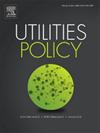A system dynamics framework to formulate energy policies for sustainable development in Ethiopia
IF 4.4
3区 经济学
Q3 ENERGY & FUELS
引用次数: 0
Abstract
Since 2010, Ethiopia has aimed to enhance its energy infrastructure for economic growth, targeting lower-middle-income status by 2025. Despite vast renewable resources, limited electricity capacity poses a challenge, necessitating impactful policies for improving energy supply and sustainable development. Conventional methods struggle with the complexity of hundreds of variables and their interactions in the energy socioeconomic system. This research constructs a simulation framework employing the system dynamics approach, which is well-suited for capturing intricate feedback loops created by variables within the energy socioeconomic system. The framework is then used to evaluate alternative policies to inform decision-makers in addressing the conflict between sustainable development and the national electricity balance in Ethiopia. Scenario simulations predict significant growth in renewable energy capacity from 2025 to 2043, driven by policies promoting economic growth, energy investment, and dam construction. Energy demand, growing at 10 % annually from 2000 to 2022, is expected to reach a 19 % growth rate between 2043 and 2050. Simulation results also reveal the significant impact of industrial and service sector growth on demand, the crucial role of universal electricity access in exacerbating deficits, and the potential risks of expanding electricity exports, highlighting the need for balanced policy planning. Policymakers should reconsider the schedule design for universal electricity access and export policies, emphasizing advanced technology in consumption and efficiency for a balanced energy system. The study concludes with policy implications, limitations, challenges, and future research directions.
制定促进埃塞俄比亚可持续发展的能源政策的系统动力学框架
自2010年以来,埃塞俄比亚一直致力于加强其能源基础设施以促进经济增长,目标是到2025年达到中等偏下收入水平。尽管有大量的可再生资源,但有限的电力容量构成了挑战,需要有影响力的政策来改善能源供应和可持续发展。传统的方法与能源社会经济系统中数百个变量及其相互作用的复杂性作斗争。本研究构建了一个采用系统动力学方法的仿真框架,该框架非常适合于捕获能源社会经济系统中由变量产生的复杂反馈回路。然后,该框架用于评估备选政策,以便为决策者提供信息,以解决埃塞俄比亚可持续发展与国家电力平衡之间的冲突。情景模拟预测,在促进经济增长、能源投资和大坝建设的政策推动下,2025年至2043年可再生能源容量将显著增长。从2000年到2022年,能源需求以每年10%的速度增长,预计在2043年到2050年之间将达到19%的增长率。模拟结果还揭示了工业和服务业增长对需求的重大影响,普遍电力接入在加剧赤字方面的关键作用,以及扩大电力出口的潜在风险,突出了平衡政策规划的必要性。政策制定者应重新考虑普及电力接入和出口政策的时间表设计,强调在消费和效率方面的先进技术,以实现平衡的能源系统。本研究总结了政策启示、限制、挑战和未来研究方向。
本文章由计算机程序翻译,如有差异,请以英文原文为准。
求助全文
约1分钟内获得全文
求助全文
来源期刊

Utilities Policy
ENERGY & FUELS-ENVIRONMENTAL SCIENCES
CiteScore
6.80
自引率
10.00%
发文量
94
审稿时长
66 days
期刊介绍:
Utilities Policy is deliberately international, interdisciplinary, and intersectoral. Articles address utility trends and issues in both developed and developing economies. Authors and reviewers come from various disciplines, including economics, political science, sociology, law, finance, accounting, management, and engineering. Areas of focus include the utility and network industries providing essential electricity, natural gas, water and wastewater, solid waste, communications, broadband, postal, and public transportation services.
Utilities Policy invites submissions that apply various quantitative and qualitative methods. Contributions are welcome from both established and emerging scholars as well as accomplished practitioners. Interdisciplinary, comparative, and applied works are encouraged. Submissions to the journal should have a clear focus on governance, performance, and/or analysis of public utilities with an aim toward informing the policymaking process and providing recommendations as appropriate. Relevant topics and issues include but are not limited to industry structures and ownership, market design and dynamics, economic development, resource planning, system modeling, accounting and finance, infrastructure investment, supply and demand efficiency, strategic management and productivity, network operations and integration, supply chains, adaptation and flexibility, service-quality standards, benchmarking and metrics, benefit-cost analysis, behavior and incentives, pricing and demand response, economic and environmental regulation, regulatory performance and impact, restructuring and deregulation, and policy institutions.
 求助内容:
求助内容: 应助结果提醒方式:
应助结果提醒方式:


